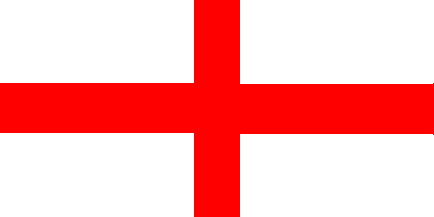 image by Andre' Serranho
image by Andre' Serranho
Last modified: 2021-08-24 by rob raeside
Keywords: genoa | genova | republic of genoa | liguria | gryphon | cross | janus | zeneise |
Links: FOTW homepage |
search |
disclaimer and copyright |
write us |
mirrors
See also:
Other Sites:
The first flag of the Republic of Genoa was red with Saint
George riding an horse, attested after 1198. The Republic used in
land after 1218 an white flag with red Saint George cross, later
also used as ensign since 1238. This flag was in use until 1805.
Jaune Ollé, 13 October 1998
Red cross on white field. This flag is listed under number 54
at the chart "Flags of Aspirant Peoples" [eba94] as: "Liguria (Genoa) -
North-West Italy."
AFAIK , Genoa is the capital of Liguria. Lega
Liguria uses more complicated flags, including the red cross
on white field.
Ivan Sache, 6 September 1999
The Statute of the Comune (Community) of Genoa states under
Title 1 - General Principles, point 4:
"The Community of Genova has its own coat of arms, its flag
- both a red cross on a white field - and its gonfalone, prized
with a golden medal for Military Value for the contribute during
the Liberation (in World War II) and it depicts Saint George
killing the dragon."(See: <www.comune.genova.it>).
The story behind this is very interesting. Here follows a brief
summary:
The vexillum beati Georgii (flag of Saint George) is first
reported in the Annales Januenses of 1198 (Genoa Yearbook). A red
flag with Saint George riding a horse and striking a dragon was
the state flag till the first half of the XIII century. A picture
of it appears in the Annales Januenses describing the capture of
the city of Savona in 1227. The banner with four tails is placed
before the Genoa commanders tents and its importance is stressed
by the author, who wrote "vexillum" under it.
Meanwhile, the Community flag, ie the red cross on a white field,
was also used. It is first reported on 28 September 1218: the
insignia cruxata comunis Janue (cross ensigns of the Community of
Genoa) were flying on the city of Ventimiglia, which surrendered
to Genoa. At this point it was a land flag only. It assumed a
modern rectangular shape, with no tails, from mid of the XIV
century. The vexillum beati Georgii is still described in 1241
for the fleet of Genoa, being the war ensign and the Admiral
proper, but in 1242 the signum Communis, ie the cross flag, was
also in use, displayed on the galleys. The vexillum beati Georgii
was flown from the commander (Podesta') galley only. Until at
least 1282 this was the Admiral standard. Today the flag of the
Comune of Genova (Genoa) is still the red cross on a white
background and the Gonfalone is the banner
with the Saint striking the dragon.
Source: Aldo Ziggioto, Genova, in Vexilla Italica 1, XX
(1993);
Aldo Ziggioto, Le Bandiere degli Stati Italiani, in Armi Antiche
1994.
Pier Paolo Lugli, 18 July 2000
I looked up Genua on the flagchart that forms the cover for
Vlaggen - Sierksma, and this shows for 1756 the "Pavillon de
Genes" to be a white flag with a red cross
Peter Hans van den Muijzenberg, 18 July 2000
In 1099 in the first crusade a Genoese fleet conquered some
cities along the coast of the Middle East. The Genoese went then
straight to Jerusalem where they gave a determined help to the
Christian warriors. Guglielmo Embriaco took the red cross up on
to the top of a hill near Jerusalem and said "Pe Zena e pe
San Zorzo" ("For Genoa and for Saint George").
Since that moment the red cross is synonymous with Genoa, even before it became
a symbol of Milan, England etc..
Filippo Noceti, 22 February 2001
I would like to invite everybody to treat carefully statements
of this kind. Crusader flags were the patterns for many following
banners and, eventually, flags, but at the time there was no
concept of flags in the modern way. Aldo Ziggioto works on the
Italian flags are the reference for everybody who wishes to study
the topic.
Pier Paolo Lugli, 22 February 2001
This is the flag of Genoa. Since 1099. It is dark red almost
maroon.
Filippo Noceti, 22 February 2001
Maybe it is true that during the crusades we can't speak of
official flags but the Republic of Genoa was born in 1099 and all
over the Mediterranean Sea a red cross meant Genoa. In 1248 at
the battle of Victoria near Parma the Genoese crossbow-men
conquered the new imperial city. Milan asked to take the red
cross and the allied Genoese allowed them to take the flag. The
Genoese and Pisan fleet cleared the western Mediterranean of the
Musulman fleet but after 1284, when Pisa was defeated at the
battle of Meloria, and remained the only maritime police (Venice
had been beaten at Corcula in 1297). When the Saracens saw the
red cross they fled and didn't attack. In 1992 for the Genoese Columbus festival in Genoa the Duke of Kent
wrote some
words about the relationship between Genoa and England in past
history: "...The St. George's flag, a red cross on a white
field, was adopted by England and the City of London in 1190 for
their ships entering the Mediterranean to benefit from the
protection of the Genoese fleet. The English Monarch paid an
annual tribute to the Doge of Genoa for this privilege..."
You can find the full text at the site <www.francobampi.it> .
In 1304 Venice took Constantinople but in 1361 the Genoese fleet
helped Michele Paleologo (schismatic Emperor) to take power in the
Eastern Empire, so the trade route to the Black Sea became
Genoese and they fortified lots of cities and the cities they
colonized in south-eastern Europe in fact have arms with a red
cross.
Filippo Noceti, 2 March 2001 and 6 June 2001
At J.W Norie - J.S. Hobbs: Flaggen aller seefahrenden
Nationen, 1971[ nor71] (original
print 1848):
197 Genoa- As above.
Peter Hans van den Muijzenberg, 12 November 2001
At the time of the World Cup football competition, many English flags were
displayed. It was reported about this time (June 2018) that the Mayor of Genoa
had asserted that the St. George's Cross, in red on white, had been the Genoese
flag originally and that the English had, with their permission, adopted it in
the 13th century as a deterrent to the Barbary Pirates when flown on English
ships in the Mediterranean. He further claimed that the English Crown had paid a
regular fee to Genoa for this privilege and that it had continued to be paid
till 1746. He asked for the payment to be resumed (with back pay).
Kenneth Fraser, 27 July 2018
The 1746 appears to be the year Genoa lost its independence. After that time,
yearly dues agreed on between the governments of the two countries would have
gone to whatever country Genoa was part of at the time. So, if 270 years of
back-payments are owed, it's not to Genoa.
The details on the original
events seem to differ with each report, but around the 11th century Genoa
adopted the St. George ensign, and England asked and got permission to fly that
ensign on English ships. Around the 13th century, it appears England adopted
that flag as their national flag and/or ensign, apparently without Genoa
protesting. It would seem that use as a national flag was not a problem, be it
because of time or of distance.
Interestingly, England in Tudor times no
longer used the St. George ensign, though ensigns derived from it seem to have
been used ever since. If England did indeed pay up until 1746, as the
burgomaster of Genoa is reported to have claimed, then Genoa owes centuries of
restitutions for the time when Genoa was paid for England using the St. George
ensign when in fact England did no such thing.
Peter Hans van den
Muijzenberg, 14 September 2018
 image contributed by Filippo Noceti, 27 June 2000
image contributed by Filippo Noceti, 27 June 2000
Official city gonfalone is this one. The Gonfalone of Genoa
represent St. George killing the Dragon
Filippo Noceti, 27 June 2000
The gonfalone of Genoa has the gold medal for the resistance
during the second world war, because Genoese fought for their
freedom by themselves.
Filippo Noceti, 19 September 2001
 image from <www.araldicacivica.it>
image from <www.araldicacivica.it>
The website <www.araldicacivica.it>
show different gonfalone.
Eli Gutterman, 10 November 2005
genov.jpg) image contributed by Filippo Noceti, 8 June 2001
image contributed by Filippo Noceti, 8 June 2001
The symbol of the city of Genoa is with Griffins, St. George
cross and at the top Janus the Roman god with two faces, the
Roman god of Genoa.
Filippo Noceti, 22 February 2001
At the base, on the both, there is the spur of a Roman
allegoric ship with the snout of a wild boar.
Filippo Noceti, 8 June 2001
I believe he meant a Roman ship with a boar's head figure on
the bow. I cannot see enough detail to confirm it, but suspect
Filippo is referring to the small embellishments upon which both
griffin supporters are resting a paw.
Ned Smith, 8 June 2001
There is an error in my previous text. . The spur is a real
thing that have been found in 1597 in the Gulf of Genoa and it's
really a part of a roman ship, it isn't an allegoric picture. Now
it's in Turin in a museum, Savoia taked it during their reign.
You can see this image on lot of Genoese monuments, like the
monument to Columbus, the Triumphal Arch built after 1st World
War or on the paint of the admiral Andrea Doria. At
www.fotodigenova.com/acquaverde6.html
you can see them all around the rounded base of Columbus monument and at
www.fotodigenova.com/piazzavittoriasf.html
on the top at the level of arch in the corners. You can see it at
the site of the Gallery of Tourin
members.it.tripod.de/~gat/collezione.htm.
Filippo Noceti, 22 June 2001
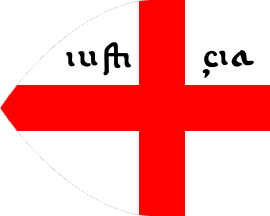 image by Eugene Ipavec, 24 December 2009
image by Eugene Ipavec, 24 December 2009
The 26th flag mentioned and illustrated in the Book of All
Kingdoms [f0fXX] is attributed to
Genoa. This as depicted in the
2005 Spanish illustrated transcription [f0f05], a white flag with a red cross
throughout, reading "iustiçia" in black letters
across the the upper half; the flag shown in the ogival default
shape of this source.
The anonymous author of [f0fXX]
describes the flag thusly: "El señor della á por señales
un pendón blanco con una cruz bermeja. Encima está escripto
«Justicia» d’esta manera" (And its lord has for sign
a white pendon with a red cross. Atop it is written «Justicia»
like this.).
The lettering reads rather "iustiçia", set in black
uncial (lower case) letters, with dotless "i",
so-called long "s" ("ſ"),
unorthographic cedilla, and ligated "sti", with
"iusti" on the upper fly quadrant and "çia"
on the upper hoist.
António Martins-Tuválkin, 15 November 2007
 image by Tomislav Todorovic, 19 May 2016
image by Tomislav Todorovic, 19 May 2016
In the Catalan Atlas [c2q75], Genoa has a
silver flag with a red cross, however the flag is very long and vertical arms of
the cross are set rather close to the hoist, so that it resembles a modern
Scandinavian flag, rather than the Cross of St George1.
Silver has darkened by age to a very dark shade of gray. It is shown at four
different places in the map, but is properly visible only at Pera, the
foreigners' quarter of medieval Constantinople which was governed by the Genoese
and marked as a separate city in the portolanos; this depiction was the basis
for the attached image. The flag hoisted over the then Genoese colony of Caffa,
present-day Feodosia, Crimea, is partly damaged, so
only the traces of vertical arms of the cross have remained. Genoa itself is
shown twice on the map because, for unclear reasons, parts of Europe and Africa,
including northwestern Italy, next to the right-hand edge of the third leaf of
the Atlas (or sixth half-leaf, as is is now divided) are repeated along the
left-hand edge of the fourth leaf (seventh half-leaf)2.
In both places, cross is not visible on the flag, which appears as having a
plain silver (now dark gray) field. It is not clear why it is so, since the
other two flags were depicted correctly, regardless of present damages3.
Sources:
[1] Catalan Atlas at
Wikipedia:
https://en.wikipedia.org/wiki/Catalan_Atlas
[2] Image of Catalan Atlas
at Wikimedia Commons:
https://commons.wikimedia.org/wiki/File:1375_Atlas_Catalan_Abraham_Cresques.jpg
Tomislav Todorovic, 19 May 2016
Notes
1 Or rather "rather than the Cross of St George
as we know it today". I'd say this long fly is how the flag was usually drawn in
the past. As it's seems to have been described as a St. George cross for some
time, what does that say about variation or development of St. George crosses?
Peter Hans van den Muijzenberg, 20 May 2016
2 I don't know about the numbering of the sides, but
apparently only pairs were expected to be seen at the same time, hence there's
overlap going to the next pair (mark of a good map). The last pair is an
exception, probably because it's not really a continuation of the previous one.
Peter Hans van den Muijzenberg, 20 May 2016
The numbering of sides is from the cited source (Wikipedia), but its external
sources also use it. First two leaves do not display the map itself, only the
third to sixth leaves do.
Tomislav Todorovic, 20 May 2016
3 Because this is truly what the flag of Genoa at home looked
like (at least according to the artist)? Then again, there seem to be traces of
red on what would be the crosses of these two. Did they use different materials
for the Genoese flags than were used for other red crosses on white on the map?
Peter Hans van den Muijzenberg, 20 May 2016
If there are traces of red (which I wasn't able to recognize), then there are
just two more damaged flags from the map - there are many flags with erased
details, so this is more likely to be the case than intentional depicting of
plain silver flags, for no other portolanos seem to depict them so.
Tomislav Todorovic,
20 May 2016
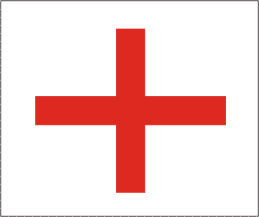 image by Jaume Ollé, 11 April 2003
image by Jaume Ollé, 11 April 2003
No. 430 - Duchy of Genoa.
Source: [stb62]
Jaume Ollé, 11 April 2003
 image by Jaume Ollé, 8 June 2003
image by Jaume Ollé, 8 June 2003
No. 649 - Genoa.
Source: [stb62]
Jaume Ollé, 8 June 2003
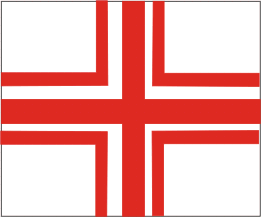 image by Jaume Ollé, 15 June 2003
image by Jaume Ollé, 15 June 2003
No. 692 - Genoa.
Source: [stb62]
Jaume Ollé, 15 June 2003
Anyone knows what is the language that is represented by a red St. George
cross on white at www.acompagna.org?
It is probably connected with Genoa or Liguria since it looks
like some cultural organization from Genoa. Their gonfalone at
www.acompagna.org/gonfalone.htm.
Dov Gutterman, 11 July 2001
The word "zeneize" means citizen of Genoa in the
local language of Genoa. The red cross on a white background is
the flag (vexillum) of Saint George, a saint which Genoa is
devoted to. This flag was adopted in the age of the first Crusade
and lately England was allowed to use it by the Republic of
Genoa.
This is a short story. You can find a longer explanation (in
English) at my
pages.
Franco Bampi, 12 July 2001
In the Liguria Region is spoken as native tongue a language
called "Ligurian" that, I think, was also the official
language of Genoa Republic. Zeneize is the local dialect of this
language spoken in the city of Genoa and is the main dialect
of this language, it's like a standard Ligurian.
Edoard Salza, 12 December 2001
In Argentina, where the dialect is also spoken (brought to the country by
immigrants -
https://it.wikipedia.org/wiki/Lingua_ligure#Storia_linguistica_esterna) the
word is translated as "xeneize" and it stands for the gold and blue colors of
the football team Boca Juniors (source:
https://en.wikipedia.org/wiki/Boca_Juniors).
Esteban Rivera, 5 June 2016
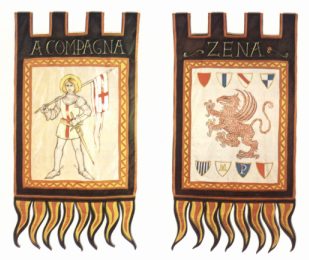 image contributed by Ivano Piermarini, 21 January 2004
image contributed by Ivano Piermarini, 21 January 2004
“A compagna” is the Association of the Genovesi
loving of Genoa and their ancient land, the ancient glories, the
beauties, the traditions, the language and the customs of their
People, beside and above every political and religious faith. In
the front part it represent Saint George (patron of Genoa and
protecting of Liguria), in steel armor. In the posterior part it
represent the figure of the “Grifo” and the coats of
arms of the eight Compagne
Genovesi: San Lorenzo, Piazza Longa, Sozziglia,
Portanuova, Borgo, Castello, Porta and Maccagnana. In the Middle
Ages, the noblest and rich citizens of Genova organized
themselves in consortia of families that lived in the
same contrade and that they had common interests. Such
consortia were named compagne.
See: <www.acompagna.org>
and <www.francobampi.it>.
Ivano Piermarini, 21 January 2004
The flag of the
Genoa Cricket and Football Club1893 is red and blue.
Corrado Mortelli, 21 February 2006
 image by António Martins-Tuválkin, 15 September 2005
image by António Martins-Tuválkin, 15 September 2005
I saw this morning in the Lisbon airport the arrival of a
large and noisy party of soccer supporters from Italy. I think
they are Sampdoria fans . Some of them had flags, apparently
mass-manufactured, matching other fan gear: Medium blue with a
wide central white stripe and and thinner red and black stripes
on it. Approximate specs: (9+3+2+2+3+9):42 = 2:3.
António Martins-Tuválkin, 15 September 2005
It is the Sampdoria flag. It is Italian football club of
Genoa, founded by the merger of two minor club in the Genoa area:
Sampierdarenese and Andrea Doria.
Paolo, 15 September 2005
I believe you might be interested in one small (very big
to a Genoese) detail about Sampdoria football club: It is not a
team from a suburb of Genoa but it is a team founded in 1946 by
the fusion of two existing teams: one was the Sampierdanerese
(which means "from Sampierdarena, a popular industrial
neighborhood of Genoa) the other one was the "Andrea
Doria" which is as Genoese as you can get (the name was
taken from the famous admiral). The name was indeed Samp + Doria
= Sampdoria. It is a football team founded by teams
well rooted in Genoese tradition. On the contrary
"Genoa Cricket and Football Club"
was founded by British citizens in Italy and won all of the
championships with a team completely made by British citizens. It
is now part of the blood and DNA of town, of course.
Paolo Tavella, 15 March 2006